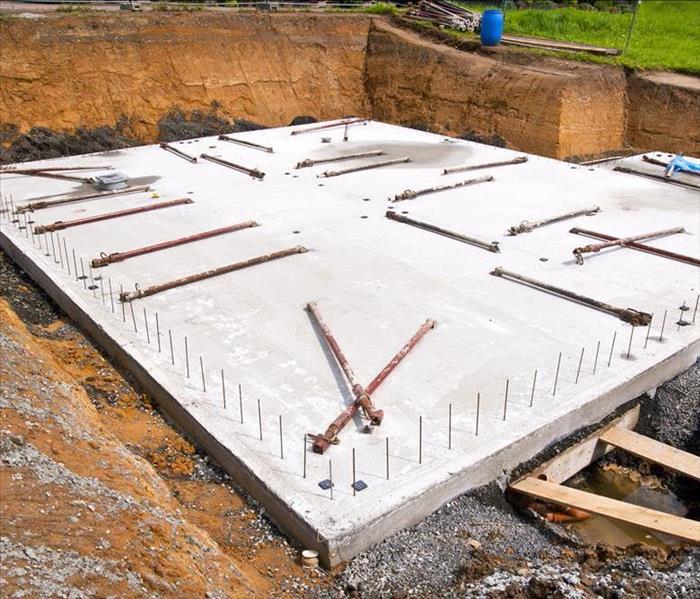3 Types of Foundations: Pros and Cons
1/5/2021 (Permalink)
The foundation of a structure is the load bearing portion, typically built below ground. This portion serves 3 purposes.
- Support the structure
- Keep out groundwater
- Function as a barrier to water and soil vapor
But, when deciding on the foundation of your home, it’s important to know the pros and cons of each option.
- Slab Foundations:
These are the most cost efficient as well as the most common of the choices. The process is simple, the slab starts with concrete footing poured 24 inches below projected finish grade. Then concrete blocks are placed on top of the footers, internal piping is placed, then rock filler is added, and four inches of concrete poured on top.
The advantages of a slab foundation are that they are low maintenance and the least expensive option. The disadvantages are that there is a higher potential for expensive repairs because plumbing is placed below the slab. This means if there is a problem, the concrete would have to be broken to reach the issues at hand. Another disadvantage is that a slab foundation has minimal protection from storms and bad weather.
- Crawlspace Foundations:
Homes with crawlspace foundations are raised a few feet off the ground. As with slab foundations, footing is placed, and concrete blocks are placed the create the support for the walls.
The advantages of a crawlspace foundation are the easy access for repairs to plumbing, electrical, piping, and ductwork. A second advantage is warmer floors. Because the floor is elevated and the underlying space is conditioned, the floors tend to be much warmer than a concrete slab. The disadvantages are that crawlspaces are prone to moisture. It is important to keep an eye on your crawlspace to ensure you have proper insulation and ventilation. Even with cutting edge vapor barriers there can still be potential for mold and fungi to grow due to increased moisture. A second disadvantage is there is, like with slab foundations, little to no protection from storm and weather.
- Basement Foundations:
A basement is an eight-foot hole that ends in a concrete slab. In the past, basements were built with cinder blocks, but they were prone to structural failures and leaks over time. Nowadays, basements are built with poured concrete walls, which have improved the structural integrity on the foundation over time.
The advantages of a basement foundation are the extended square footage, easy access for repairs, and storm protection. Having the additional space at a much lower cost per square foot than other parts of the house can create extra living space or entertainment. As with crawlspace foundations, there is easy access for repairs. However, unlike slab and crawlspace foundations, there is protection from storms and weather for you and the residents of the home. The disadvantages of a basement foundation are increased costs. Because of the added materials, labor, and square footage, the costs on installation are the most time consuming and expensive. Another disadvantage is lack of natural light. Because the foundation is underground, there are no possible options for windows, unless you create a walkout.
Ultimately, the decision on which foundation you choose is personal preference. There is no foundation type that “holds up” better than another. However, if you do experience flooding or mold issues in your Oxford, MS home, give SERVPRO of Oxford/Batesville/Clarksdale a call at 662-281-1881!!






 24/7 Emergency Service
24/7 Emergency Service
